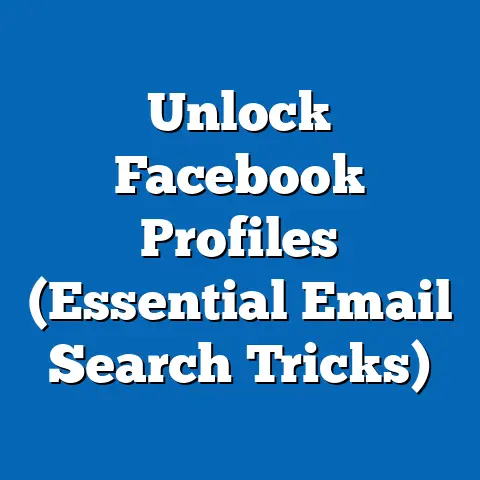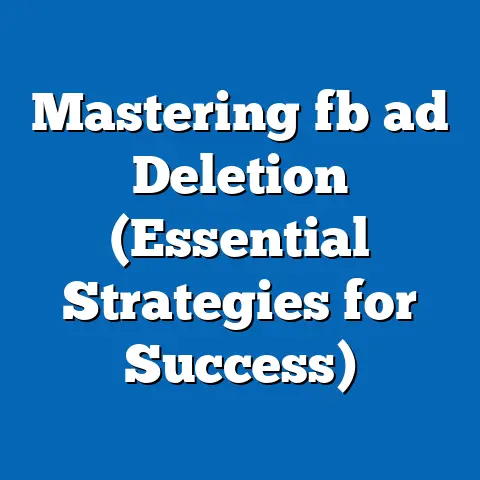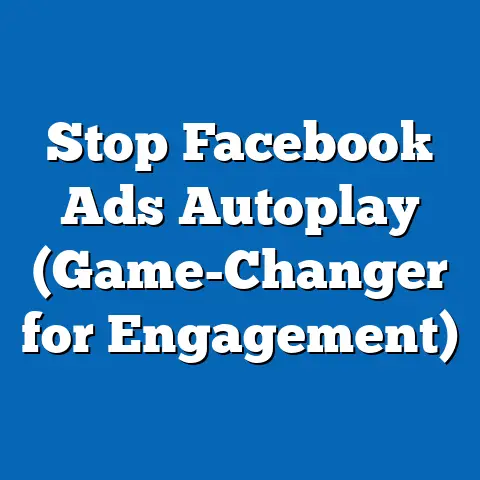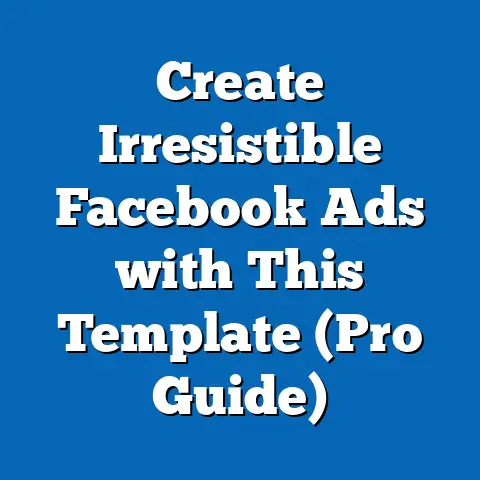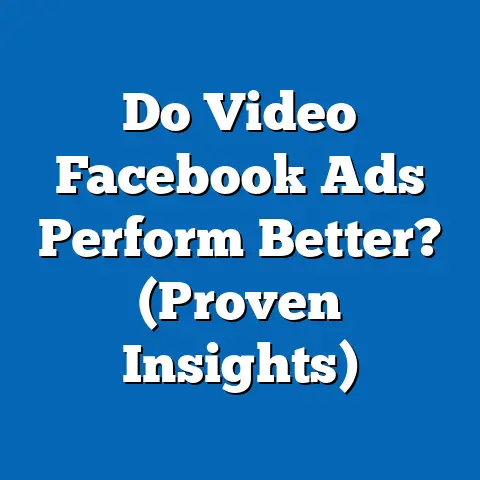Lower Facebook Ad CPC Now (Expert Cost-Saving Tips)
Facebook advertising has come a long way since its early days. I remember when I first started experimenting with Facebook Ads back in 2010 – it felt like the Wild West! Targeting options were basic, the ad formats were limited, and the whole platform felt a bit…experimental. Fast forward to today, and Facebook (now Meta) is a sophisticated advertising powerhouse. We’ve seen upgrades in Facebook’s advertising platform—such as improved targeting options, enhanced analytics, and advanced bidding strategies—have transformed the landscape for advertisers. These upgrades provide powerful tools for reaching audiences, but they also come with a higher price tag. Cost-per-click (CPC) has steadily climbed, and many advertisers are feeling the pinch. It’s not enough to just “boost a post” anymore; you need a strategic, data-driven approach to get the best bang for your buck.
That’s why I wrote this article. I’m going to share effective strategies to lower your CPC while maximizing your ad performance. I’ll be diving into the latest Facebook features, time-tested optimization techniques, and some insider tips I’ve picked up over years of running countless campaigns. Whether you’re a seasoned pro or just starting out, you’ll find actionable advice here to help you slash your CPC and boost your ROI.
Understanding Facebook Ad CPC
Let’s start with the basics: What exactly is CPC, and why does it matter so much?
1. What is CPC?
CPC stands for Cost-Per-Click. It’s the amount you pay each time someone clicks on your Facebook ad. For example, if you spend $100 and get 100 clicks, your CPC is $1.00. Simple, right?
2. Why is CPC important?
CPC is a crucial metric because it directly impacts your advertising budget. A high CPC means you’re paying more for each visitor to your website or landing page. This can quickly eat into your budget and limit the number of people you can reach. Conversely, a low CPC allows you to drive more traffic for the same amount of money, increasing your chances of conversions and sales.
Think of it like this: If you have a $1000 budget, a $1.00 CPC gets you 1000 clicks. But if you can lower your CPC to $0.50, you get 2000 clicks for the same budget! That’s double the potential reach and impact.
3. How is CPC calculated?
Facebook uses an auction system to determine ad costs. Your CPC is influenced by several factors, including:
- Your Bid: How much you’re willing to pay for a click.
- Ad Relevance: How relevant your ad is to the target audience.
- Estimated Action Rates: How likely people are to click on your ad.
- Ad Quality: The overall quality of your ad, including its visual appeal and messaging.
- Competition: The number of other advertisers bidding for the same audience.
Facebook’s algorithm aims to deliver the most relevant ads to users at the lowest possible cost to advertisers. This means that simply bidding the highest amount doesn’t guarantee the lowest CPC. You need to optimize your ads for relevance and quality to win the auction.
4. The Importance of Achieving a Low CPC
Achieving a low CPC is vital for several reasons:
- Budget Optimization: A lower CPC allows you to stretch your budget further, reaching more potential customers.
- Increased ROI: By driving more traffic for less money, you can significantly improve your return on investment (ROI).
- Competitive Advantage: A lower CPC gives you a competitive edge by allowing you to outbid competitors and capture more market share.
- Scalability: Lowering your CPC makes it easier to scale your campaigns without breaking the bank.
Takeaway: Understanding CPC and its influencing factors is the first step towards lowering your advertising costs. By focusing on relevance, quality, and strategic bidding, you can significantly improve your campaign performance.
Leveraging Facebook Upgrades for Cost Savings
Facebook is constantly evolving its advertising platform, introducing new features and capabilities. Mastering these upgrades is key to unlocking cost savings.
1. Advanced Audience Targeting
Facebook’s audience targeting options are incredibly powerful. I’ve seen firsthand how precise targeting can dramatically lower CPC. Here’s how to leverage it:
- Detailed Targeting: Use detailed targeting to narrow your audience based on demographics, interests, behaviors, and connections. For example, if you’re selling yoga mats, you can target people interested in yoga, meditation, and fitness. Don’t just pick broad categories; dig deeper into specific interests.
- Custom Audiences: Create custom audiences based on your existing customer data, such as email lists or website visitors. This allows you to target people who are already familiar with your brand, increasing the likelihood of engagement and conversion. I once ran a campaign targeting a custom audience of email subscribers, and the CPC was 50% lower than targeting a broad interest-based audience.
- Lookalike Audiences: Expand your reach by creating lookalike audiences based on your custom audiences. Facebook will find people who share similar characteristics and behaviors with your existing customers. This is a great way to reach new potential customers who are likely to be interested in your products or services.
Tip: Avoid overly broad targeting. The more specific your audience, the more relevant your ads will be, leading to a lower CPC.
2. Creative Optimization
Your ad creatives play a huge role in determining your CPC. Compelling visuals and engaging copy can capture attention and drive clicks. Here are some best practices:
- High-Quality Visuals: Use professional-quality images or videos that are visually appealing and relevant to your target audience. Avoid blurry or low-resolution images.
- Compelling Copy: Write clear, concise, and benefit-driven copy that highlights the value of your offer. Use strong calls to action (CTAs) that encourage people to click.
- A/B Testing: Continuously test different ad creatives to see what resonates best with your audience. Test different headlines, images, and CTAs to identify the most effective combinations. I usually create at least three different ad variations for each campaign and track their performance closely.
Example: Instead of using a generic stock photo, showcase real customers using your product or service. This adds authenticity and can significantly improve engagement.
3. Utilizing Facebook’s Ad Insights
Facebook Ads Manager provides a wealth of data that you can use to optimize your campaigns. Here’s how to leverage it:
- Monitor Key Metrics: Track metrics like click-through rate (CTR), relevance score, and conversion rate to identify high-performing ads and audiences.
- Analyze Performance: Use the data to understand which ads are driving the most clicks at the lowest cost. Identify any underperforming ads and pause or revise them.
- Relevance Score: Pay close attention to your ad’s relevance score. A higher relevance score indicates that your ad is highly relevant to the target audience, which can lower your CPC.
Personal Experience: I once had a campaign with a low relevance score. After analyzing the data, I realized that the ad copy was not aligned with the target audience’s interests. I revised the copy to be more relevant, and the relevance score increased, resulting in a significant drop in CPC.
Takeaway: Facebook’s advanced features provide powerful tools for optimizing your campaigns and lowering your CPC. By mastering audience targeting, creative optimization, and ad insights, you can significantly improve your advertising performance.
Strategic Bidding Techniques
Your bidding strategy is another critical factor in determining your CPC. Choosing the right bidding technique can help you control costs and maximize your ROI.
1. Manual vs. Automatic Bidding
Facebook offers two main bidding options: manual and automatic.
- Manual Bidding: With manual bidding, you set the maximum amount you’re willing to pay for each click. This gives you more control over your CPC, but it also requires more monitoring and optimization.
- Automatic Bidding: With automatic bidding, Facebook automatically sets your bids based on your campaign goals and budget. This is a good option for beginners or for campaigns where you want to prioritize reach and conversions over CPC.
When to Use Each Method:
- Manual Bidding: Use manual bidding when you have a specific CPC target in mind or when you want to test different bidding strategies.
- Automatic Bidding: Use automatic bidding when you’re unsure of the optimal bid amount or when you want to maximize conversions within your budget.
2. Bid Cap Strategies
Setting a bid cap can help you control costs while still achieving your desired reach and engagement. A bid cap is the maximum amount you’re willing to pay for each click.
- How to Implement Bid Caps: In Facebook Ads Manager, you can set a bid cap when creating or editing your ad set. Choose a bid cap that is slightly above your target CPC to ensure that your ads are still competitive in the auction.
- Examples of Effective Bid Caps: If your target CPC is $0.50, you might set a bid cap of $0.60. This allows Facebook to bid up to $0.60 for each click, but it prevents your CPC from exceeding that amount.
3. Ad Scheduling
Ad scheduling, also known as dayparting, allows you to schedule your ads to run only during specific times of the day or days of the week. This can be particularly effective if you know when your target audience is most active on Facebook.
- Why Ad Scheduling Matters: By scheduling your ads to run during peak activity times, you can improve engagement and lower your CPC. For example, if you’re targeting working professionals, you might schedule your ads to run during lunchtime or after work hours.
- How to Implement Ad Scheduling: In Facebook Ads Manager, you can set an ad schedule when creating or editing your ad set. Choose the days and times when you want your ads to run.
Takeaway: Strategic bidding techniques can significantly impact your CPC. By choosing the right bidding method, setting bid caps, and scheduling your ads effectively, you can control costs and maximize your ROI.
Continuous Testing and Iteration
The key to long-term success with Facebook advertising is continuous testing and iteration. The platform is constantly evolving, and what works today may not work tomorrow.
1. The Importance of A/B Testing
A/B testing, also known as split testing, involves testing different variations of your ads to see which performs best. This is essential for identifying the most cost-effective combinations of ad elements.
- What to Test: You can A/B test various ad elements, including headlines, images, CTAs, and targeting options.
- How to Conduct A/B Tests: Create two or more variations of your ad, each with a different element being tested. Run the ads simultaneously and track their performance. The ad with the best performance is the winner.
Structured Approach to A/B Testing:
- Identify a Variable: Choose one element of your ad to test (e.g., headline).
- Create Variations: Create two or more variations of your ad, each with a different headline.
- Run the Test: Run the ads simultaneously and track their performance.
- Analyze the Results: Analyze the data to see which headline performed best.
- Implement the Winner: Use the winning headline in your future ads.
2. Scaling Successful Campaigns
Once you’ve identified a campaign that is performing well in terms of low CPC, you’ll want to scale it to reach a larger audience. However, it’s important to scale carefully to avoid CPC inflation.
- Scaling Strategies:
- Gradual Scaling: Increase your budget gradually to avoid overwhelming the system.
- Audience Expansion: Expand your target audience by adding new interests or creating lookalike audiences.
- Ad Creative Refresh: Refresh your ad creatives to avoid ad fatigue.
- Gradual Scaling: Increase your budget gradually to avoid overwhelming the system.
- Audience Expansion: Expand your target audience by adding new interests or creating lookalike audiences.
- Ad Creative Refresh: Refresh your ad creatives to avoid ad fatigue.
3. Retargeting Campaigns
Retargeting involves showing ads to people who have already interacted with your brand, such as website visitors or app users. Retargeting can lead to lower CPC because these users are already familiar with your brand and are more likely to click on your ads.
- How Retargeting Works: Install the Facebook Pixel on your website or app to track user behavior. Create custom audiences based on this data and target them with retargeting ads.
- Segmenting Retargeting Audiences: Segment your retargeting audiences based on their behavior. For example, you can target people who viewed a specific product page or added an item to their cart but didn’t complete the purchase.
Takeaway: Continuous testing and iteration are essential for optimizing your Facebook ad campaigns and lowering your CPC. By A/B testing different ad elements, scaling successful campaigns carefully, and implementing retargeting strategies, you can achieve long-term success.
Utilizing Facebook’s Additional Features
Facebook offers a range of additional features that can help you lower your CPC and improve your advertising performance.
1. Dynamic Ads
Dynamic ads automatically show the right products to people who have expressed interest on your website or app. This can lead to lower CPC because the ads are highly relevant to the users.
- How Dynamic Ads Work: Connect your product catalog to Facebook and create dynamic ad templates. Facebook will automatically show the right products to the right people based on their behavior.
- Benefits of Dynamic Ads:
- Increased Relevance: Dynamic ads are highly relevant to the users, leading to higher engagement and lower CPC.
- Automated Optimization: Facebook automatically optimizes the ads based on user behavior, saving you time and effort.
- Increased Relevance: Dynamic ads are highly relevant to the users, leading to higher engagement and lower CPC.
- Automated Optimization: Facebook automatically optimizes the ads based on user behavior, saving you time and effort.
2. Facebook Shops and Marketplace
Integrating Facebook Shops or Marketplace can enhance your visibility and potentially lower your CPC by targeting users at various stages of the buying journey.
- Facebook Shops: Create a shop on Facebook to showcase your products and allow users to purchase directly from Facebook.
- Marketplace: List your products on Facebook Marketplace to reach a wider audience and drive traffic to your website or shop.
3. Engaging with Facebook Groups
Engaging with niche Facebook groups can help you build community and drive traffic to your ads, which can help reduce your CPC due to increased relevance and interest.
- How to Engage: Join relevant Facebook groups and participate in discussions. Share valuable content and build relationships with other members.
- Promote Your Ads: When appropriate, promote your ads in the groups. However, be careful not to be too promotional, as this can alienate group members.
Takeaway: Facebook’s additional features provide valuable tools for lowering your CPC and improving your advertising performance. By utilizing dynamic ads, integrating Facebook Shops and Marketplace, and engaging with Facebook groups, you can reach a wider audience and drive more traffic to your website or shop.
Conclusion
Facebook advertising is a powerful tool for reaching your target audience and achieving your marketing goals. However, with rising CPCs, it’s essential to adopt a strategic and data-driven approach to your campaigns. Throughout this article, I’ve shared expert cost-saving tips that you can implement to lower your CPC and maximize your ROI.
Remember, the key to success is to continually adapt your strategies in response to the evolving landscape of Facebook advertising. By mastering audience targeting, creative optimization, strategic bidding, continuous testing, and Facebook’s additional features, you can effectively lower your Facebook ad CPC while maintaining high engagement and conversion rates.
I encourage you to implement the cost-saving tips shared in this article and track your results closely. With the right approach, you can maximize your ROI and achieve your marketing goals efficiently. Don’t be afraid to experiment and try new things. The world of Facebook advertising is constantly changing, and the more you learn and adapt, the more successful you’ll be. So, go out there, create some amazing ads, and watch your CPC plummet!

